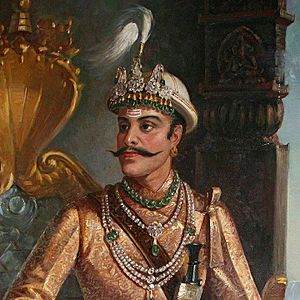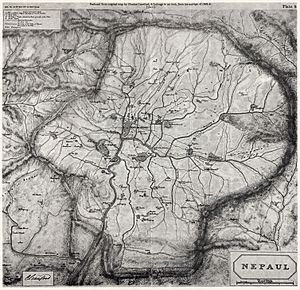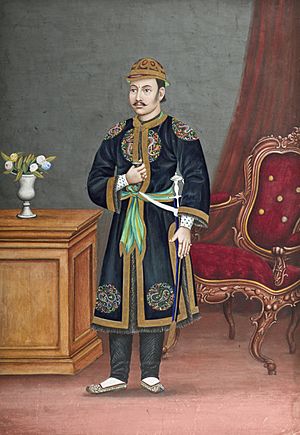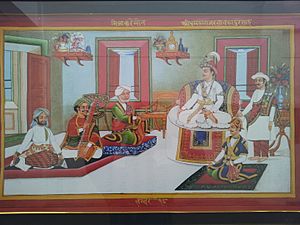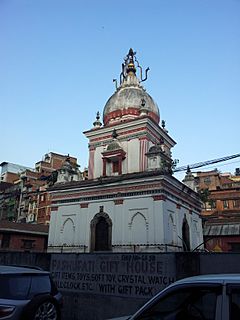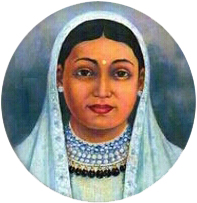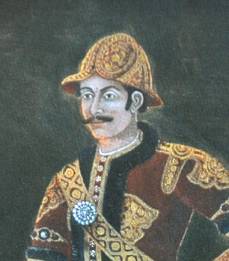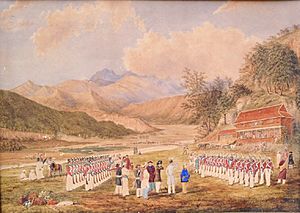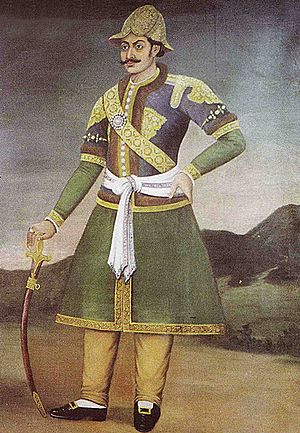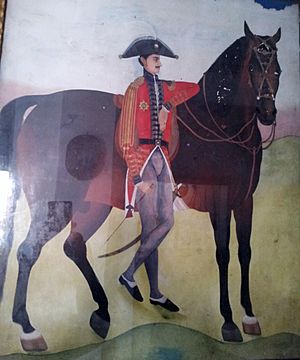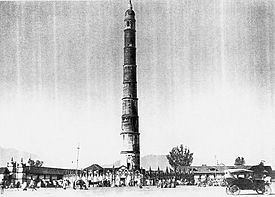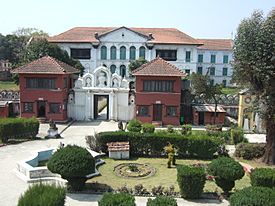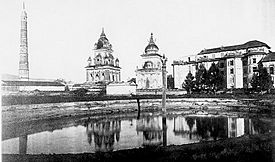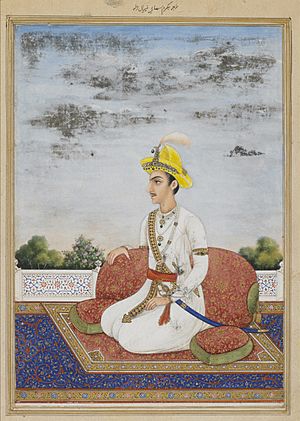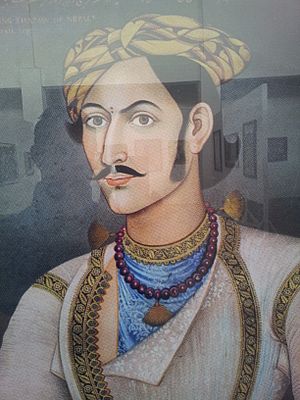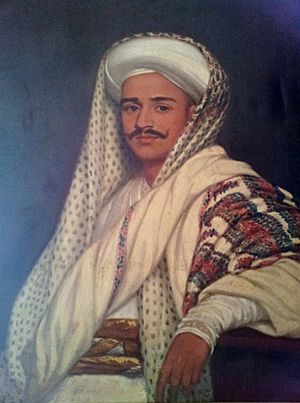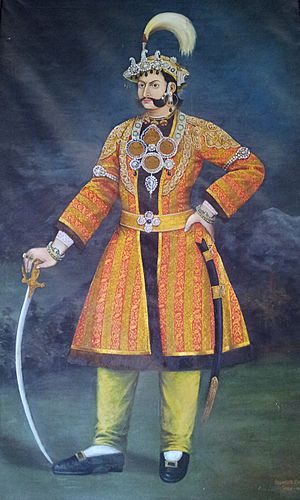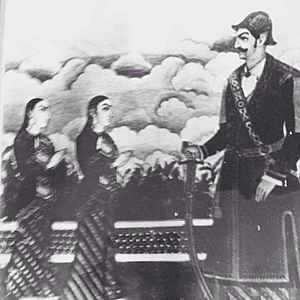Bhimsen Thapa facts for kids
Quick facts for kids
Sri Mukhtiyar General
Bhimsen Thapa
|
|
|---|---|
|
श्री मुख्तियार जर्नेल
भीमसेन थापा |
|
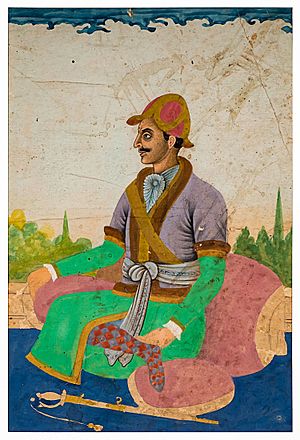
Sri Bhimsen Thapa, Mukhtiyar (Prime Minister of Nepal) from 1806 to 1837
|
|
| Mukhtiyar of Nepal (Prime Minister of Nepal) | |
| In office 1806–1837 |
|
| Monarch | Girvan Yuddha Bikram Shah Rajendra Bikram Shah |
| Preceded by | Rana Bahadur Shah as Mukhtiyar |
| Succeeded by | Rana Jang Pande |
| Pradhan Senapati (Chief General) & Commander-In-Chief of the Nepalese Army | |
| In office 1811- 14 June 1837 |
|
| Preceded by | Damodar Pande as Pradhan Senapati |
| Succeeded by | Rajendra Bikram Shah |
| Personal details | |
| Born | August 1775 Pipal Thok village, Gorkha region, Kingdom of Nepal (present-day Pipal Thok, Bhimsen Thapa R.M., Gorkha district, Gandaki Province, Nepal) |
| Died | 29 July 1839 (aged 63) Bhim-Mukteshwar, bank of Bishnumati River, Kathmandu, Nepal |
| Relations | see Thapa dynasty, Pande dynasty, Kunwar family, Rana dynasty |
| Children | Lalita Devi Pande Janak Kumari Pande Dirgha Kumari Pande |
| Parents |
|
| Residences | Thapathali Durbar (1798–1804), Bagh Durbar (1804–1837) |
| Military service | |
| Allegiance | |
| Branch/service | Nepal Army |
| Years of service | 1798–1837 |
| Rank | Commander-in-Chief |
| Commands | Commander-in-Chief |
| Battles/wars | Anglo-Nepalese War |
Bhimsen Thapa (Nepali: भीमसेन थापा (August 1775 – 29 July 1839)) was a very important leader in Nepal. He served as the Mukhtiyar, which was like a prime minister, and was the real ruler of Nepal from 1806 to 1837. He is known as the longest-serving Prime Minister of Nepal. King Mahendra Bir Bikram Shah later named him one of the "National heroes of Nepal".
Bhimsen Thapa came from a military family in the Gorkha Kingdom. He became close to Crown Prince Rana Bahadur Shah in 1785. In 1798, his father helped him become a bodyguard to the King. He gained power after helping the exiled ex-King Rana Bahadur Shah return to power in 1804. Rana Bahadur then made Bhimsen a Kaji, which was like a minister. After Rana Bahadur's death in 1806, Bhimsen took charge. He became the Mukhtiyar and remained in power even after Nepal lost the Anglo-Nepalese War. This was partly due to the support of Queen Tripurasundari.
Bhimsen Thapa was the first Nepalese leader to understand how the British were expanding their power in India. He worked hard to keep Nepal independent from the British Empire. During his time, the Gurkha empire reached its largest size, stretching from the Sutlej River in the west to the Teesta River in the east. However, Nepal fought the Anglo-Nepalese War against the East India Company from 1814 to 1816. Nepal lost about one-third of its land in this war, which ended with the Treaty of Sugauli.
Despite the war, Bhimsen Thapa is remembered for many good changes. He brought social, religious, economic, and administrative reforms. He also modernized the Nepalese Army like the French Army. He built many temples and monuments, including the famous Dharahara tower, also known as Bhimsen Stambha. Bhimsen Thapa is seen as a clever and patriotic leader who helped protect Nepal from British influence. He was also praised for improving how the government worked.
Contents
Early Life and Family
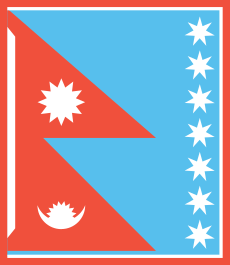
Bhimsen Thapa was born in August 1775. His birthplace was Pipal Thok village in Gorkha district. His father was Amar Singh Thapa (sanu), and his mother was Satyarupa Maya. Bhimsen belonged to a Chhetri family of courtiers. His family, the Bagale Thapa clan, came from Jumla. They later moved east. His grandfather, Bir Bhadra Thapa, was a courtier in Prithvi Narayan Shah's army.
Bhimsen Thapa had four brothers: Nain Singh, Bakhtawar Singh, Amrit Singh, and Ranbir Singh. He also had two step-brothers, Ranbam and Ranzawar. Bhimsen had three wives. He had one son who died young in 1796. He also had three daughters: Lalita Devi, Janak Kumari, and Dirgha Kumari. Since he had no surviving son, he adopted Sher Jung Thapa, who was his brother Nain Singh's son or grandson.
Not much is known about Bhimsen Thapa's very early life. When he was 11, he met the Nepalese Royal family. This was during his Bratabandha (sacred thread) ceremony in Gorkha in 1785. In 1798, his father brought him to Kathmandu. He became a bodyguard to the king. Bhimsen first lived in Thapathali. Later, he moved to Bagh Durbar near Tundikhel after becoming a Kaji.
Rise to Power
Royal Family Challenges
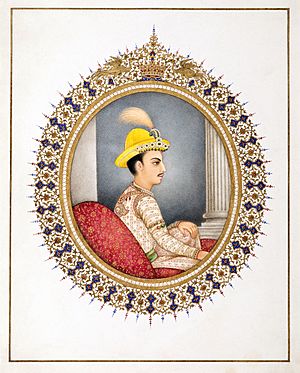
After King Pratap Singh Shah died young, his son Rana Bahadur Shah became king at two and a half years old. This created a power vacuum in Nepal. Different regents, like Queen Rajendra Lakshmi and Bahadur Shah, ruled for him. Court life was full of rivalries between these regents.
In 1794, Rana Bahadur Shah became old enough to rule. He removed his uncle, Bahadur Shah, from power. In 1795, he married Kantavati Jha and promised to make their son the heir, even though he had an older, legitimate son. In 1797, Rana Bahadur ordered his uncle's imprisonment and death. This made many people, especially Brahmins, unhappy with him.
In 1797, Girvan Yuddha Bikram Shah was born and quickly named crown prince. When Kantavati became ill, Rana Bahadur, at 23, gave up his throne to his son in 1799. He made his first wife, Rajrajeshwori, the regent. Bhimsen Thapa and his father were promoted around this time. Bhimsen became the ex-King's chief bodyguard.
Rana Bahadur's decision to give up the throne did not last long. After Kantavati died, he became very upset. He tried to take back his royal power. This led to a conflict with the courtiers who supported King Girvan. Damodar Pande led the military against the ex-King. Rana Bahadur realized he couldn't win. He fled to Varanasi, a British-controlled city, in May 1800.
Exile in Varanasi
Bhimsen Thapa went with Rana Bahadur Shah to Varanasi as his bodyguard and advisor. Rana Bahadur wanted to regain power. He tried to get help from the British. He offered them a trading post in Kathmandu and a share of tax revenue. However, the British preferred to work with the existing government in Nepal.
Bhimsen Thapa was very involved in these plans. He is believed to have handled negotiations with the British. He also wrote letters in the ex-King's name to divide the courtiers in Kathmandu. He tried to turn them against Damodar Pande. Bhimsen understood the British system of "protectorates" and worked to keep them away.
Meanwhile, Rajrajeshwari, Rana Bahadur's first wife, returned to Nepal in 1801. She aimed to become the regent. In Kathmandu, the chief minister, Kirtiman Singh Basnyat, was secretly killed. This led to confusion and arrests. A new treaty was signed with the British in 1801. A British Resident, Captain William O. Knox, came to Kathmandu. Rajrajeshwari eventually became regent in December 1802.
Return to Kathmandu

Rajrajeshwari was pressured to pay a pension to the ex-King. This would help pay off his debts in Varanasi. The Nepalese court also thought it was better to have Rana Bahadur in Nepal, not in British India. Rajrajeshwari's presence caused more unrest among courtiers. Knox tried to interfere in Nepal's politics. Rajrajeshwari then changed the government, making Damodar Pande the chief minister. Knox left Kathmandu.
The British annulled the treaty in 1804. This allowed Rana Bahadur to return to Nepal. When Rana Bahadur and his group came back, the troops sent to stop them joined him instead. Damodar Pande and his men were arrested. Rana Bahadur took revenge on those who had exiled him. He exiled Rajrajeshwari and executed Damodar Pande and his two sons. Many others were tortured or killed.
Bhimsen Thapa was made a second kaji (minister). Ranajit Pande, Bhimsen's brother-in-law, became the chief minister. Sher Bahadur Shah, Rana Bahadur's half-brother, became the chief Chautariya. Those who helped Rana Bahadur were rewarded.
As Kaji (Minister): 1804–1806
Expanding Westward
When Bhimsen gained power, Nepal's territory reached Garhwal in the west. Garhwal had to pay a yearly amount to Nepal. In 1804, Garhwal refused to pay. Bhimsen sent an army led by Bada Kaji Amar Singh Thapa (not his father), Bhakti Thapa, and Hasti Dal Shah. In May 1804, at the Battle of Khurbura, the Garhwali king was killed. Nepal's territory then extended to the Sutlej river in the west.
In 1805, as the army prepared for the Kangra campaign, soldiers started leaving. Bhimsen ordered his brother Nain Singh to arrest them.
Baisathi Haran (Land Reform)
In 1805, Bhimsen created a plan to take back tax-free land. This land had been given to temples and Brahmin priests. The goal was to fill the empty government treasury. The money was used to fund military campaigns in the west. This was a big change in a very religious society. It became known as Baisathi Haran.
Bhandarkhal Event of 1806
After returning to Kathmandu, Bhimsen and Rana Bahadur took over palaces and properties. This made Sher Bahadur Shah, Rana Bahadur's half-brother, and his group angry. They felt left out. Bhimsen was gaining a lot of power. He was making big changes like Baisathi Haran.
Bhimsen wanted to remove his rivals. He was careful with royal family members. For two years, Rana Bahadur had no official role. But he used his power. He carried out Baisathi Haran on Bhimsen's advice. He also banned unvaccinated children and their parents from town during a smallpox outbreak. This was to protect King Girvan.
On February 26, 1806, Rana Bahadur was made Mukhtiyar (chief authority). Bhimsen learned of a plot to remove Rana Bahadur. Tribhuvan Khawas, a member of Sher Bahadur's group, was imprisoned. He was accused of conspiring with the British. He then revealed others involved, including Sher Bahadur Shah.
On April 25, 1806, Rana Bahadur met with courtiers. He threatened Sher Bahadur. Around 10 PM, Sher Bahadur killed Rana Bahadur Shah with a sword. This led to a large event in Bhandarkhal. Members of Sher Bahadur's group, like Bidur Shah and Tribhuvan Khawas, were quickly arrested and killed. Over the next few days, Sher Bahadur Shah's sons, aged 2 to 15, were killed. Their wives and daughters were given to untouchables. Their property was seized. Bhimsen removed anyone who disagreed with him or could cause future problems. In this event, 93 people died.
Before this, Rana Bahadur had married 14-year-old Tripurasundari. Bhimsen became the Mukhtiyar (1806–37). Tripurasundari was named regent and Queen Mother (1806–32) for the young King Girvan. Bhimsen was the first person outside the royal family to be Mukhtiyar. He made sure other courtiers obeyed him. He moved old courtiers to far-off provinces. His close relatives, who supported him, replaced them. Bhimsen later built the Rana-Mukteshwar temple where Rana Bahadur died.
As Mukhtiyar (Prime Minister): 1806–1832
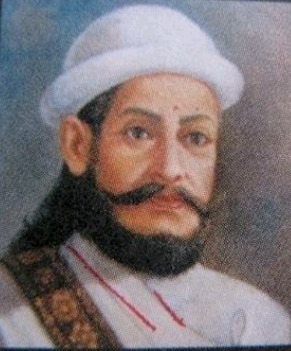
Continued Expansion
Bhimsen had planned the conquest of the Garhwal Kingdom and the Kangra campaign. Gorkhali forces under Badakaji Amar Singh, Rudrabir Shah, and Nain Singh took over Nalagarh. They crossed the Sutlej river and defeated King Sansar Chand of Kangra in May 1806. Sadly, Bhimsen's brother Nain Singh was killed during the conquest of Kangra fort in 1806–07.
By 1809, most of Kangra land was part of Nepal. Sansar Chand sought help from the Sikhs of Punjab. By August 1809, the Nepalese army had to retreat due to the combined forces of Sansar Chand and Ranjit Singh. Other states like Salyan were also added to Nepal. Before the Anglo-Nepalese War, Nepal stretched from the Sutlej river in the west to the Teesta river in the east. Most of this land was lost in the war. In 1811, Bhimsen was given the title of General. This meant he was both Mukhtiyar and General.
Anglo-Nepalese War: 1814–1816
The Anglo–Nepalese War (1814–1816), also called the Gorkha War, was fought between Nepal and the British Empire's East India Company. Border tensions, trade disputes, and both sides wanting to expand caused the war. Bhimsen had made his father, Amar Singh Thapa, the governor of Palpa. This led to serious border disputes with the British. A dispute over the border in Butwal, Terai, was the immediate cause of the war in 1814.
Bhimsen Thapa was a strong supporter of the war with the British. This was against the advice of leaders like Bada Kaji Amar Singh Thapa, who knew the difficulties of war. Bhimsen believed the British would attack the Doon area first, which was correct. The British launched two invasions. The Nepalese army was led by members of the Thapa family.
During the war, Bhimsen tried to form an alliance with Ranjit Singh of the Sikh Empire and Daulat Rao Scindia of Gwalior State. He wanted them to fight the British together. But these rulers did not want to join a losing side. The war ended with the Treaty of Sugauli in 1816. Nepal lost about one-third of its land to the British. Nepal also had to allow a permanent British resident in Kathmandu. Nepal lost control over its foreign affairs. As Commander-in-Chief, Bhimsen Thapa was responsible for Nepal's defeat.
Keeping Power
In May 1816, Edward Gardner became the first British Resident in Kathmandu. Bhimsen worked to keep peace with the British. His foreign policy was to keep Nepal isolated from foreign influences. He had to accept a British resident, but he limited their contact with Nepalese life. The resident was mostly confined to Kathmandu Valley and needed special escorts. They could not meet the King or courtiers freely.
On November 20, 1816, King Girvan Yuddha died at age nineteen. His only son, Rajendra Bikram Shah, became king at two years old. Bhimsen Thapa, with the help of Queen Regent Tripurasundari, stayed in power despite the war defeat. There was opposition from other families, like the Pandes. They criticized Bhimsen for giving in to the British.
Bhimsen modernized the Nepal army after the war. He used it to control his opposition. He appointed his family and trusted men to high positions. Older aristocratic families were sent to govern distant provinces. Bhimsen made all the country's decisions. Queen Regent Tripurasundari approved them without question.
Bhimsen also made sure the King, his wives, and the Regent were only influenced by him and his relatives. His youngest brother, Ranvir Singh Thapa, watched the royal family. No one could meet the King or Queens without Ranbir Singh's approval. The royal family also needed Bhimsen's permission to leave the palace. Bhimsen neglected Rajendra's education, making him less critical. However, the Queens learned news from their handmaidens, who went outside the palace.
Policies and Reforms
Historian Henry Ambrose Oldfield said Bhimsen strengthened Nepal after the war. He did this through military, financial, and economic policies.
Defence Policy
Military Modernization
Bhimsen reorganized the Nepalese Army based on European military systems. He used money from confiscated lands to pay for this. He hired French military experts to modernize the army. Military jobs became attractive with better benefits. He made it compulsory for all adult males to provide labor for the state. This labor was used for building forts, bridges, roads, and making ammunition.
Passport Policy
Bhimsen saw the Churia hills as Nepal's main defense line. He wanted to build roads to western parts like Kumaon and Garhwal. He also wanted to block routes to the Kathmandu valley. Passers-by were strictly searched. Private letters were censored. This was to prevent secret information from reaching the British East India Company.
Trade and Economic Policies
Bhimsen Thapa's trade policy was like King Prithvi Narayan Shah's. He believed foreign traders would weaken Nepal's economy. Customs offices were moved to make it easier for local traders. Local traders were given support. Officials were warned not to bother them. He increased customs duties. State revenue grew from 80,000 rupees in 1816 to 250,000 rupees in 1833.
After 1807, markets were opened in the Terai and Inner Terai. This helped local traders. For example, market towns were built in Hitaruwa (Makawanpur) and Bhadaruwa (Saptari) in 1809. Indian traders were also encouraged. Nepalese officials were told to develop border markets and protect land. In 1811, timber exports from Chitwan to Calcutta began. Mining and minting coins were also done by Bhimsen's government.
Judicial Reforms
Bhimsen introduced the idea of Equality before the law in Nepal. Farmers often paid taxes with crops because cash was scarce. He told landlords to accept foodgrain as tax. He also said landlords were responsible for getting cash, not the farmers. He issued rules against bribery. Landlords, officials, and regional officers were taking bribes. Bhimsen made it illegal to give or take bribes.
In 1829 and 1830, fires destroyed shops in Ridi and Tansen. Merchants asked for the right to build concrete shops. Bhimsen agreed. He allowed individual rights on the property. Before Bhimsen, Nepal's administration was chaotic due to unification wars. In Achham Province, landlords and traders were charging high interest on loans. Farmers revolted. Bhimsen helped the victims. He ordered outstanding debts to be cancelled.
Slavery Reforms
In 1807, Bhimsen's government ordered tax officials to collect taxes in cash. They also ordered the freedom of enslaved farmers who couldn't pay taxes. No farmer would be enslaved for not paying taxes. In 1812, he restricted human trade in Garhwal and Sirmur. Children of debtors were taken by traders for loan interest and sold. Feudal lords treated slaves as non-human. Bhimsen challenged this.
In 1830, Bhimsen restricted Danuwar traders in Western Nepal from buying and selling Kariya slaves. He also freed slaves from their owners. This gave legal rights to slaves. Six years later, he banned the sale of children among the Magar community. Bhimsen made slave trading illegal in many parts of Nepal. This was a great achievement, especially compared to other powerful nations at the time.
Socio-Religious Reforms
Customs like birth and death ceremonies among the Newar community led to indebtedness. Priests charged high fees. Not following customs could lead to being outcast. In 1830–31, Bhimsen set limits on ceremonial fees and spending.
Land Management Reforms
Around 1808, Bhimsen ordered the development of unused lands in the Terai region. This was to increase government income. He offered irrigation to settlers. In areas with few tenants, farmers were given land with tax exemptions. Loans were provided to new settlers. This policy was very successful in Eastern Terai. Officials were appointed in 1811 to manage this.
Postal Reforms
A postal system from Kathmandu to the west was set up in 1804. It used porters in relays. In 1808, it was reported that minors were working in postal services in small villages. Bhimsen's government increased the number of relays in these villages. It also said that forcing minors or women into personal postal services would be punished. Some porters were paid with land, others with cash.
Foreign Policy
Bhimsen was known for his negative stance against British imperialism. He believed in "Asian Unity" against the British. He restricted the British Resident from interfering in Nepal's politics. He also stopped the Resident from having secret contacts with Nepalese citizens. He wanted the British Resident to be just an ambassador. He saw British Residents as troublemakers who encouraged conflicts to colonize states. He understood the British system of protectorates.
After the 1816 war, Bhimsen prevented direct communication between British Residents and the King. Resident Brian Houghton Hodgson disliked this. Historian William Wilson Hunter said the British Residency was a center of anti-Bhimsen politics. Historian Nayaraj Panta believed Bhimsen's actions saved Nepal, the only Hindu Kingdom, from British influence.
Heritages Built
In 1811, Bhimsen built a bridge over the Bagmati River at Thapathali. This connected Kathmandu and Patan. In 1825, he built the famous Dharahara Tower for Queen Tripurasundari of Nepal. He had already built a taller Dharahara for himself in 1824. The taller one fell in the 1833 Nepal earthquake and was not rebuilt. The smaller Dharahara had 11 stories before the 1934 Nepal earthquake reduced it to two. The original Dharahara built by Bhimsen was 225 feet tall. It was completely destroyed in the 2015 Nepal earthquake. It was recognized by UNESCO. Dharahara is seen as a great symbol of Bhimsen's legacy. Building two such towers in two years was a unique architectural feat.
In 1811, he also built Bagh Durbar to live closer to Basantapur Palace. He had moved from Gorkha district to Thapathali Durbar first. Bagh Durbar had a large garden, a pond, and temples. The National Museum of Nepal at Chhauni was once Bhimsen's home. It has bronze sculptures, paintings, and weapons, including a sword from Napoleon Bonaparte.
Challenges to Power
Royal Family Issues
The power balance began to shift when King Rajendra grew up. His grandmother, Tripurasundari, died in 1832. Bhimsen lost his main support. The court became a place of power struggles. King Rajendra wanted to assert his authority. He feared Bhimsen and the Thapa faction. Bhimsen kept his power because of the large army he and his family controlled. After Tripurasundari's death, the royal seal went to the senior queen, Samrajya Laxmi. She wanted to become regent.
In 1833, Bhimsen created a new army unit, "Singha Nath." His nephew Mathabar Singh commanded it. Ranbir Singh, Bhimsen's brother, tried to turn Samrajya Laxmi against Bhimsen. He hoped to become Mukhtiyar. Mathabar Singh supported Bhimsen. A disagreement happened between Mathabar Singh and Ranbir Singh. Mathabar Singh resigned from his command. The King then made Mathabar Singh General Commander of the Eastern districts. Bhimsen scolded Ranbir Singh, who then resigned and retired. Bhimsen later made Ranbir Singh "Little General" and sent him to Palpa as governor. Bhimsen started living in a rented house near the palace to keep an eye on the royal family.
Royal Family's Influence
The King and Queens began to openly challenge Bhimsen. Rajendra and his wives heard rumors that Bhimsen had caused the death of King Girvan. So, when Rajendra got sick, the Queens warned him not to take medicine from Bhimsen's loyal physician. In 1833, during the annual review of officers, Rajendra delayed confirming Bhimsen's position as Mukhtiyar.
This forced Bhimsen to share power with Rajendra and Samrajya Laxmi. Rajendra was in charge of defense, finance, and foreign relations. Samrajya Laxmi handled justice, accounting, and civil administration. Rajendra was heavily influenced by Samrajya Laxmi. The King and Senior Queen were still afraid to dismiss Bhimsen due to his army. This arrangement worked for three years. For example, during a big earthquake in 1833, they all worked together to help the citizens.
Queen Samrajya Laxmi wanted to be as powerful as Queen Tripurasundari. She was frustrated that King Rajendra couldn't remove Bhimsen. In 1835, she left the palace in anger. She demanded a new army unit and money for her children. But she didn't succeed.
Rivalry with British Envoy
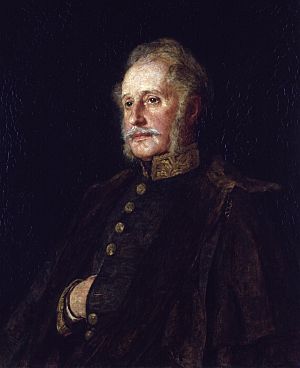
In 1833, Brian Houghton Hodgson became the new British Resident. Bhimsen knew the British wanted to colonize states. He saw them as a threat that caused conflicts. Historian William Wilson Hunter said the British Residency was against Bhimsen. Bhimsen had kept British Residents from talking directly to the King since 1816. Hodgson saw Bhimsen as a strong opponent. He wanted to talk directly to the King and remove Bhimsen from power.
Hodgson started writing negative reports about Bhimsen to the Governor General. He claimed Bhimsen sidelined the Pande family and gave all high ranks to his relatives. However, many Pandes held high positions. Bhimsen even called back his rivals like Rana Jang Pande to government jobs. Bhimsen also gave judicial powers to a Pande family member, Dalabhanjan Pande. Historian Chittaranjan Nepali believes Hodgson's reports were attempts to defame Bhimsen.
Hodgson also made up stories about Bhimsen promoting young relatives to high commands. He claimed King Rajendra refused medicine because he thought Bhimsen's doctors had poisoned his father and grandfather. However, King Rajendra's grandfather, Rana Bahadur Shah, died from a sword attack. His father, Girvan Yuddha Bikram Shah, died of smallpox. Historian Chittaranjan Nepali believes these were lies by Hodgson.
Mathabar Singh Thapa's Failed Mission to Britain
The British Resident was supposed to stay out of Nepal's internal politics. But both the King and Bhimsen tried to get Hodgson's support. Hodgson wanted to increase British influence. He also thought Nepal's large army was a threat. By 1834, Hodgson believed he couldn't succeed while Bhimsen was in power. He supported the Pande family.
In August 1834, Hodgson suggested a new trade treaty. Bhimsen agreed in principle but disagreed with some parts. Bhimsen tried to be friendly with Hodgson to gain him as an ally. He loosened restrictions on Hodgson's movements and allowed him direct access to the King.
Nepal received a letter from Maharaja Ranjit Singh of Punjab. The Nepalese court used this to reconnect with Punjab and other states. In April 1835, Bhimsen planned a state visit to Britain. He hoped Britain would recognize Nepal's independence. Since he couldn't go, his nephew Colonel Mathabar Singh Thapa was chosen. Mathabar Singh was promoted to Chota General. His brother, Ranbir Singh, became Full General. Mathabar's nephew, Sher Jung Thapa, became Commanding Colonel. This helped Bhimsen keep his military power.
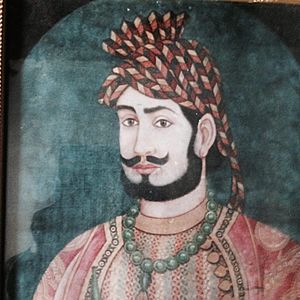
Mathabar Singh left for London in November 1835 with many men. He was welcomed in Calcutta. But Hodgson secretly told the Governor-General not to allow Mathabar to visit Britain as a state representative. Mathabar was only offered a visa as an ordinary traveler. He returned to Nepal in March 1836, having wasted a lot of money. This failure hurt Bhimsen's political standing. People believed Bhimsen's good relationship with the British kept Nepal safe. This mission showed that wasn't true. Mathabar's spending was criticized. Bhimsen had to pay for extra expenses himself.
Rise of the Kala Pandes
By this time, Rana Jang Pande, son of Damodar Pande, was an army captain in Kathmandu. He knew about the conflict between Samrajya Laxmi and Bhimsen. He secretly promised loyalty to Samrajya Laxmi. He wanted to bring Bhimsen down for what he did to his family. Bhimsen had actually brought back Rana Jang and his brothers to government posts earlier. Historian Chittaranjan Nepali believes Bhimsen's kindness to his rivals led to his downfall. In 1834, Rana Jang asked the King to restore his family's properties. The King agreed.
Rana Jang also tried to contact the Chinese Amban in Lhasa. He falsely claimed Bhimsen was too close to the British. The court was divided between the two queens. The Senior Queen supported the Pandes, and the Junior Queen supported the Thapas. After Mathabar's return, a child was born from his relationship with his widowed sister-in-law. This was a common practice, but the Pande faction used it to defame Mathabar. Mathabar Singh had to leave Kathmandu. Bhimsen made him governor of Gorkha.
With Mathabar gone, his army units were given to other courtiers in 1837. Bhimsen still kept his and his family's positions. An investigation began into Bhimsen's spending on army units. Courtiers felt Bhimsen's time as Mukhtiyar was ending. Ranbir Singh, hoping to be the next Mukhtiyar, asked to return to Kathmandu. Bhimsen, happy to see his brother, made Ranbir Singh acting Mukhtiyar. Bhimsen then went to his ancestral home in Gorkha for a pilgrimage. But he also wanted to bring Mathabar back.
While Bhimsen was away, King Rajendra created a new army unit, Hanuman Dal, for himself. By February 1837, Rana Jang and his brother, Ranadal Pande, were promoted to kaji. Rana Jang became the King's personal secretary and chief palace guard. This limited Bhimsen's access to the royal family. On June 14, 1837, the King took command of all army units. He became Commander-in-Chief.
Poisoning Case
On July 24, 1837, Rajendra's youngest son, Devendra Bikram Shah, died suddenly. A rumor spread that the child died from poison meant for his mother, Queen Samrajya Laxmi Devi. It was said Bhimsen or his group caused it. Bhimsen, his brother Ranbir Singh, his nephew Mathbar Singh, their families, and court physicians were arrested. They were declared outcasts, and their property was taken. The physicians, Ekdev and Eksurya, were spared because they were Brahmins. Bhajuman Baidya, a deputy, was killed. Ekdev confessed that Bhimsen told him to poison Devendra and King Girvan.
Most historians agree Bhimsen was not behind the poisoning. He had nothing to gain from killing a baby. The accusation was likely a trick to explain his imprisonment. It was common for physicians to test medicine on the mother first. It was later rumored that the Junior Queen tried to poison the Senior Queen. The poison killed the infant prince instead, and Bhimsen was blamed. Historian William Wilson Hunter said the charge was invented by the Pandis. Hodgson's reports also showed King Rajendra knowingly blamed Bhimsen due to personal dislike.
Dismissal and Pardon
After the Thapas were arrested, a new government was formed. Ranganath Paudel led the civil administration. Dalbhanjan Pande and Ranajang Pande led the military. The Pandes became the dominant group. They started preparing for war with the British to regain lost territories. This worried Resident Hodgson and other court groups. They saw the aggressive policy as dangerous for Nepal. After three months, the King removed Ranjang as Mukhtiyar. Ranganath Paudel, who favored the Thapas, became the sole Mukhtiyar.
King Rajendra, fearing a rebellion, restricted Bhimsen's "Singhanath" army unit from leaving Kathmandu Valley in March 1838. Bhimsen's case was reopened. To prevent the Pandes from regaining power, Fatte Jang Shah, Mukhtiyar Ranga Nath Poudel, and the Junior Queen Rajya Laxmi Devi helped free Bhimsen, Mathabar, and their family in March 1838. This was about eight months after their arrest for the poisoning case. Some of the Thapa family's confiscated land and the Bagh Durbar were returned. When Bhimsen was released, loyal soldiers cheered him. Mathabar Singh and Sher Jung Thapa received similar treatment. All their confiscated properties were returned by the end of 1838. Bhimsen was pardoned but not reinstated. He retired to his home in Borlang, Gorkha.
Ranganath Poudel resigned as Mukhtiyar because the King didn't support him. Pushkar Shah became Mukhtiyar, but Ranjang Pande held the real power. In March 1838, King Rajendra sent Mathabar Singh on a secret mission to Sikh Emperor Ranjit Singh. The British arrested him. He was later deported to Shimla by the Sikh Emperor. Ranbir Singh gave up his property and became a monk. Bhimsen Thapa stayed in Gorkha. The Pandes now had full power. They flattered the King and promised the army war and plunder.
Aftermath
Bhimsen Thapa's death did not end the power struggles in the court. Five months after Bhimsen died, Ranajang Pande became prime minister again. But he couldn't control the lawlessness in the country. He resigned, and Pushkar Shah became prime minister. Pushkar Shah was not as anti-British as Ranajang. During his time, a border dispute with the British in April 1840 led to British troops near the border. Pushkar resolved it peacefully. There was also a brief army mutiny in June 1840. Soldiers protested cuts to their salaries. They vandalized houses of noblemen. The mutiny ended when King Rajendra agreed not to cut salaries. Resident Hodgson sent a negative report about the Nepalese government. The Governor-General demanded the King dismiss the government. Pushkar Shah and his Pande allies were dismissed. Fatte Jang Shah became Prime Minister in November 1840.
The death of the Senior Queen Samrajya Laxmi allowed the Junior Queen Rajya Laxmi and Crown Prince Surendra to become more involved in politics. To gain influence, Rajya Laxmi got a pardon for Sher Jung Thapa and other jailed Thapa family members. This allowed Bhimsen Thapa to have a symbolic funeral in August 1841. The Nepalese court was then split into three groups: the King's, the Queen's, and the Crown Prince's. Fatte Jung's government supported the King. The Thapas supported the Junior Queen. The Pandes supported the Crown Prince. The Thapa group caused conflict between Fateh Jung's ministry and the Pande group. The Pandes were imprisoned. Fatte Jung maintained order for two years. In January 1843, under pressure, the King gave the highest authority to his Junior Queen, Rajya Laxmi.
The Queen invited Mathabar Singh Thapa back after six years in exile. When he arrived, an investigation into Bhimsen's death happened. Many of his Pande enemies were killed. Ranajang Pande was already mentally ill. He was paraded through the streets and forced to watch his family members die. Then he was forced to take poison. By December 1843, Mathabar Singh became prime minister. But after a year, he angered both the King and Queen by supporting Surendra for the throne. On May 17, 1845, his nephew, Jang Bahadur Kunwar, assassinated him. This ended the Thapa family's power. It set the stage for the Kot massacre and the start of the Rana Dynasty. This was a dictatorship of hereditary prime ministers, based on Bhimsen Thapa's system. These events brought stability to Nepal but at the cost of political and economic progress.
Personal Life
Bhimsen Thapa had three wives. This is known from a stone inscription at the Bhimbishwar Mahadev temple. His only son died young in 1796. His three daughters – Lalita Devi, Janak Kumari, and Dirgha Kumari – married Pande nobles. They married Uday Bahadur Pande, Shamsher Bahadur Pande, and Dal Bahadur Pande. Uday Bahadur and Colonel Shamsher Bahadur were sons of Kaji Bir Keshar Pande. Sardar Dal Bahadur was the son of Bir Keshar's cousin, Garud Dhoj Pande. They were all related to MulKaji Ranajit Pande.
In 1820 CE, Bhimsen's mother, Satyarupa Maya, wrote a document. It said her five sons should not divide their ancestral property until her death. She died later that year. The ancestral property was then divided in 1820 CE.
| Bir Bhadra Thapa | |||||||||||||||||||||||||||||||||||||||||||||||||||||
| Satyarupa Maya | Amar Singh Thapa | ? | |||||||||||||||||||||||||||||||||||||||||||||||||||
| Bhimsen Thapa | Nain Singh Thapa | Bakhtawar Singh Thapa | Amrit Singh Thapa | Ranbir Singh Thapa | Ranbam Thapa | Ranzawar Thapa | |||||||||||||||||||||||||||||||||||||||||||||||
| ? (son) | Lalita Devi Pande | Janak Kumari Pande | Dirgha Kumari Pande | ||||||||||||||||||||||||||||||||||||||||||||||||||
Legacy and Character
His Character and Influence
Bhimsen Thapa was a military leader and the real ruler of Nepal. He is considered one of Nepal's national heroes. People saw him as clever, far-sighted, politically smart, and diplomatic. Historian Chittaranjan Nepali said Bhimsen was a selfless nationalist who never accepted foreign control. Historian Ludwig Stiller called him a very clever statesman. He was seen as a patriotic nationalist who had great control over the Kingdom.
British historian Perceval Landon wrote that Bhimsen was a powerful figure. Historian Baburam Acharya called Bhimsen "unjust" but a "devoted patriot." He said Bhimsen developed agriculture and rewarded innovations. Acharya also called him a military dictator with control over 6,000 armed forces. However, historian Kumar Pradhan disagreed. He said Bhimsen wasn't a dictator because his position was renewed yearly. Pradhan also noted that Bhimsen didn't manipulate the army. This was clear when no soldiers supported him after he was removed.
Pradhan explained that Nepal's administration allowed people to move up. Many Thapa courtiers were appointed before 1816. No single family had complete control. Bhimsen didn't have a monopoly because rules were issued in the King's name. Historian Chittaranjan Nepali said Bhimsen was as powerful as Prime Minister Jung Bahadur Rana. But Bhimsen never tried to make his position hereditary, unlike Jung Bahadur.
Resident Hodgson, who helped bring Bhimsen down, later praised him. In 1839, Hodgson called Bhimsen one of the most capable leaders in South Asia, besides Ranjit Singh. British historian Henry Ambrose Oldfield said Bhimsen cared deeply about his country's independence. Historian Ludwig Stiller said Bhimsen was more of a politician than a ruler. He criticized historians who either praised him too much or called him a "schemer." Stiller believed Bhimsen's power was limited, and he had to negotiate with other courtiers.
Nepalese-Canadian author Manjushree Thapa has written about him.
Physical Appearance
Historian Chittaranjan Nepali described Bhimsen as a tall person with an impressive physical presence.
Memorials and Tributes
There is a park named Bhimsen Park in Gorkha Municipality. It is a two-kilometer walk from Gorkha Durbar. The park is 3 ropani (about 0.38 acres) of land. Thapa family descendants used it for rituals during the Dashain festival.
Bhimsen Thapa Memorial Day is celebrated on July 25. Historian John Whelpton received the 2018 Bhimsen Thapa Memorial Award. This was given by the Bhimsen Thapa Memorial Foundation in Kathmandu.
Cultural Depictions
Nepalese playwright Balkrishna Sama wrote a play about him called Bhimsen Ko Antya. This play won the 2029 Bikram Samvat (around 1972-1973 CE) Sajha Purashkar. Historian Chittaranjan Nepali's biography of Bhimsen won the 2013 Bikram Samvat (around 1956-1957 CE) Madan Puraskar in the sociology category.
Popular Stories
Historian Chittaranjan Nepali mentioned some popular stories about Bhimsen. In 1955, General Kaiser Shumsher Jung Bahadur Rana shared a legend. It said Bhimsen cursed the King of Nepal to always eat from a full measure of grain. Another story said Bhimsen's body disappeared from where he died. It was believed that the family of Chautariya Fatte Jang Shah kept his hands. His skull was supposedly kept secretly in London. It was also believed that Fatte Jang's family worshipped Bhimsen's preserved remains every year.
Gallery
-
Portrait of Ujir Singh Thapa, Bhimsen's warrior nephew.
-
Letter received by Mukhtiyar (PM) Bhimsen Thapa and 2nd Kaji (Deputy PM) Ranadhoj Thapa from Bada Kaji Amar Singh Thapa.
-
Letter received by Mukhtiyar (PM) Bhimsen Thapa and 2nd Kaji (Deputy PM) Ranadhoj Thapa from Kaji Ranabir Singh Thapa.
See also
 In Spanish: Bhimsen Thapa para niños
In Spanish: Bhimsen Thapa para niños


